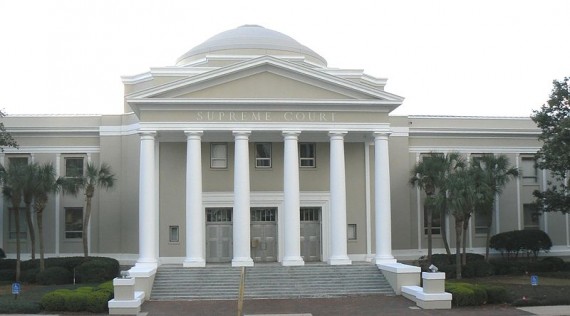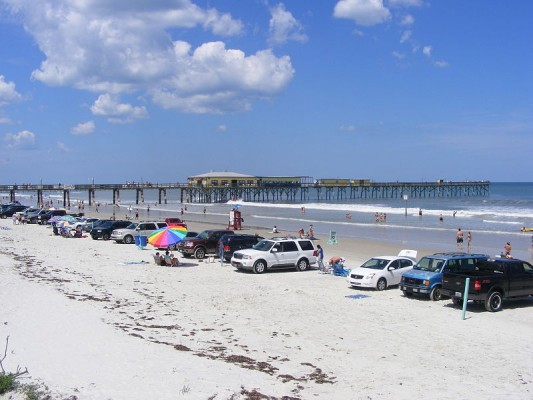 Florida, the United States’ incredibly flat protrusion into the sub-tropics, is an enormous and rapidly changing state, perhaps about to overtake New York as the third most populous state in the Union, and by far the biggest of the battleground states with 29 Electoral Votes in play.
Florida, the United States’ incredibly flat protrusion into the sub-tropics, is an enormous and rapidly changing state, perhaps about to overtake New York as the third most populous state in the Union, and by far the biggest of the battleground states with 29 Electoral Votes in play.
Florida entered political legend when the 2000 Presidential contest in the state came down to just a few hundred votes out of more than 5.8 million cast. Weeks of scrutinising disputed ballots and bitter court battles ended with George W Bush winning the state, and with it the Presidency, by just 537 votes after an acrimonious US Supreme Court decision. The world watched in horrified fascination as the nation that has always claimed to be planet’s foremost democracy descended into national crisis over malfunctioning voting machines, butterfly ballots and the notorious hanging chads.
Florida is familiar to many foreigners, of course, as a holiday destination and mainstay of popular culture from Miami Vice to Ricky Martin to CSI: Miami, and has even earned that ultimate indication of pop culture aristocracy, its own Grand Theft Auto game.

Florida is large and complex, and it’s an 11 hour drive from the conservative Gulf Coast military city of Pensacola, very much part of the Deep South, to the ethnic kaleidoscope of the Carribbean’s unquestioned metropolis, Miami, where the politics of Havana and Port au Prince command almost as much attention as those of Washington. With over 1,000 miles of coastline and year-round warmth in most of the state, Florida attracts thousands of immigrants every week, whether New York and Chicago retirees, even more retirees from Britain and Germany, or young working people across the United States and the nations of the Caribbean. At the start of World War 2, Florida was still a sleepy Deep South state, home to just 1.8 million people, with the first retirement condos and beach holiday hotels for New Yorkers having made their appearance in Miami during the interwar period. In the 70 years since, the population has increased tenfold, and Florida has become a parallel political and cultural universe, with an ethnic and social heterogeneity that produces close elections.
Like two other key swing states, Colordo and Nevada, Florida was one of the epicentres of the great American real estate bust, and negative equity and repossession are serious problems in the state. Ghost estates litter Brevard County as they do County Kildare. One of the ironies of the Obama presidency is that under his rule, it is the sunbelt states of his new Democratic coalition which have suffered the most, while old Democratic rustbelt has bounced back dramatically.
All of North Florida belongs to the Deep South, culturally, economically and politically, and this is the Sunshine State’s GOP heartland. Five counties in the region are ‘dry’, prohibiting all alcohol sales.
The Panhandle, which cast 490k votes last time, is the most conservative part of the state, sharing much in common with the Gulf Coast regions of Alabama and Mississippi which it borders. This region has swung heavily to Republicans over the past two decades, and with an African American population relatively low for the Deep South, now posts enormous GOP shares of the vote – even John McCain managed over 80% in Holmes County. Pensacola, the region’s largest city and unsurprisingly the least strongly Republican part of the panhandle, has not supported a Democrat for President since John F Kennedy. The region’s increasingly Republican lean is demonstrated by the fact that while it generated a 120k vote lead for George W Bush in the knife edge election of 2000, McCain netted an almost 180k advantage.

On the opposite coast, where the Atlantic crosses from Florida into Georgia, Jacksonville is another one of those Southern metropolises virtually unknown in Europe despite its large and ever expanding population and booming economy. High turnout among the large Black population in inner-city Jacksonville was not enough to stop John McCain taking a 110k vote lead out of the nearly 670k cast in the First Coast region.
North Central Florida, with its magnolia-lined roads, is slightly more competitive. Democrats win around Gainesville, home to the enormous University of Florida, and keep the Republican margins low in retiree-heavy Ocala, the region’s two largest cities. Some of the rural counties post enormous Republican margins, but others are more mixed, whether due to a large African American population or a heavy smattering of retirees. Overall, McCain took a lead of 47k out of a total vote of half a million in 2008.
Democrats’ one region of relative strength in Florida’s deep north is the Big Bend region, where the Panhandle Coast turns south to form Florida’s main peninsula. State capital Tallahassee is the big population centre in the region. With a large African American population, two big universities with their attendant academic elements, and a high population of public employees, this is the Democrats’ real North Florida stronghold. Some rural counties also vote Democrat here, especially where the Black Belt’s sweep nips briefly across the Georgia line. Overall, the incumbent took a 32k lead from 220k Big Bend votes last time.
South of this area, Florida changes dramatically. The demographics, religious attitudes and politics of the Deep South give way to a state unlike any other in America. Central and South Florida are what the melting pot looks like with the heat turned up.

The most politically competitive area, and one of the most intensely contested in this election, is the 85 mile long corridor following the I-4 freeway from Tampa to Orlando. Unlike both the north and the south of the state, where elections are often driven by how motivated rigid ethnic and cultural blocs are to vote, this area is packed with key swing groups. WASP retirees from the Northeast and Midwest are thick on the ground here, as are young and well-educated high-tech workers and socially liberal but fiscally conservative, high-income, women. How well a rapidly exploding Puerto Rican population in the corridor turns out to vote will be another major determinant of Florida’s political destiny. This is another area where voters are sort of used to living at political ground zero, but heartily sick of the election by this stage.
Orlando anchors Central Florida, perhaps best known for Disneyworld. This region has a high population of sun-seeking retirees, not just from other parts of the US, but from Europe as well. Although tourism and servicing retirees are key parts of the economy, Central Florida also has a big high-tech sector, with enormous defence-related electronics facilities and a significant computer game industry. Film-making is also a big local economic activity. Orlando itself is a Democratic stronghold, but the more conservative counties outside, packed with very high-income retirees, mean that W won this region, albeit very narrowly, twice. Barack Obama managed a lead just shy of 67k, in a region which cast almost 970k votes last time.
The seaside condo complexes and suburban sprawl of the Tampa Bay area follow a similar voting pattern to Central Florida, although Gore won this region before Bush swept all four counties of the metro area, narrowly, in 2004. Barack Obama took a lead of just 65k votes out of an enormous total of 1.28 million cast in Florida’s second metropolis.
South of Tampa Bay, the south west coast is another big retirement area, and one which was relatively lightly populated before exploding with new developments in the past 3 decades or so. The old rural Florida element remains a significant section of the electorate here, and this area has particular attraction from retirees from other parts of the South giving it a more conservative bent than similar South Florida regions. McCain managed a lead of just under 80k from a total vote of 860k in this region.
Inland South Florida, away from the hotels and cities of the coast, is the self-styled Florida Heartland, the southernmost exclave of the Deep South, which resembles regions 300 miles to the north more than its neighbours. Before the Democrats’ final collapse among White Southerners, this area tended to have a clear, but far from overwhelming, Republican lean. Although locals’ political preferences have shifted, an influx of outsiders, although less dramatic than in other parts of South Florida, has meant headline voting figures have not changed much in recent years. John McCain took a lead of 30k from 330k votes cast in the Heartland.

Florida’s long Atlantic coast is another crucial swing area. Most counties in this region have areas of real strength for both parties, as well as high concentrations of swing voters. Tourism and retirement are part of the economic story here, but so is the Kennedy Space Centre. This part of the state has been hit particularly heavily by the real estate collapse and home repossessions and abandonments. This is a something of bellwether region, with Bush winning narrowly twice and Barack Obama eking out a margin of just 20k or so out of 850k votes cast.

The final part of Florida’s complex regional jigsaw is the Greater Miami area, whose four counties cast over 2.2 million votes in the last election, giving a margin of 530k to the incumbent, more than twice his total margin of victory in the Sunshine State. Voting here is driven by loyal ethnic blocs, with Republicans doing well among Cubans and high-income Whites, and Democrats netting large votes from the Jewish, African American, Haitian and non-Cuban Latino communities. While the Jewish school principal from New York retired to Palm Beach is a classic election stereotype, his Black colleague retired to Fort Lauderdale is less celebrated, but just as important to Democratic hopes of victory in the State. Democrats also cite evidence that younger, Florida-born, Cubans are much more balanced in their voting preferences than their parents and grandparents.
Obama’s huge 2008 vote in this region was driven by massive turnout among minority communities. How able he will be to repeat this is open to serious question. Early voting, key for Obama, was massively curtailed in Florida this year, and the total number of early votes cast seems to be not much different from 2008 (final figures aren’t yet available) despite significant population growth.
Early voting curtailment may put the state beyond the incumbent’s reach. RealClearPolitics.com pegs the Romney polling average lead at 1.8%, Huffington Post finds it to be much closer at 0.2%, but both agree the challenger has his nose in front in the Sunshine State. Barack Obama visited Florida yesterday, while Mitt Romney started out there this morning, a sign that both regard the state as still in play. Unlike 2000, Democrats can probably afford to lose Florida and still win the Electoral College. The GOP can’t.
Romney’s definite mini-surge in the final few weeks probably makes him just about safe here, and moved the front line to the rust belt, and those other swing-states changed dramatically by rapid population growth, Colorado and Virginia.
Follow me at twitter.com/gerrylynch and facebook.com/gi0rtn and catch up with all my blog posts at sammymorse.livejournal.com
Discover more from Slugger O'Toole
Subscribe to get the latest posts to your email.
